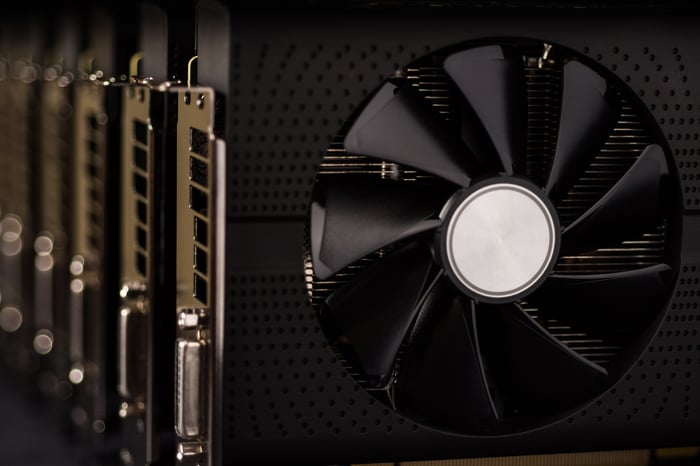Stock market corrections and bear markets are a normal part of the long-term investing cycle. Nevertheless, substantial downside in equities tends to catch investors off guard. The 2022 bear market, which saw the three major U.S. stock indexes deliver their worst returns since 2008, provides a perfect example.
When equities head lower or uncertainty builds on Wall Street, investors will always try to find the proverbial light at the end of the tunnel. Over the past two years, stocks enacting splits have been that ray of positivity.

Image source: Getty Images.
Stock-split stocks have taken center stage
A stock split is an event that allows a publicly traded company to alter its share price and outstanding share count without having any effect on its market cap or operations. It's a purely cosmetic change that can either lower a company's share price (known as a forward stock split) or increase a company's share price (a reverse stock split). The latter is typically done to ensure continued listing on a major stock exchange, while the former is designed to make shares more nominally affordable for everyday investors who don't have access to fractional-share purchases through their broker.
Without question, it's forward stock splits that garner most of Wall Street's attention. Companies conducting forward stock splits are usually out-innovating their competition and executing on their strategic initiatives.
Since July 2021, eight top-tier companies have enacted forward stocks splits, including:
- Nvidia (NVDA 6.18%), which completed a 4-for-1 split on July 20, 2021.
- Amazon (AMZN 3.43%), which executed a 20-for-1 split on June 6, 2022.
- DexCom (DXCM -9.90%), which enacted a 4-for-1 split on June 13, 2022.
- Shopify (SHOP 1.11%), which concluded its 10-for-1 split on June 29, 2022.
- Alphabet (GOOGL 10.22%) (GOOG 9.96%), which closed a 20-for-1 split on July 18, 2022.
- Tesla (TSLA -1.11%), which finished its 3-for-1 split on Aug. 25, 2022.
- Palo Alto Networks (PANW 0.91%), which finalized a 3-for-1 split on Sept. 14, 2022.
- Monster Beverage (MNST 0.41%), which fulfilled its 2-for-1 split on March 28, 2023.
As we motor into the scorching-hot month of July, one of these eight stock-split stocks stands out as a phenomenal value for patient investors, while another will likely have an exceptionally difficult time generating a positive return for new buyers.
The stock-split stock to buy hand over fist in July: Alphabet
Despite an exceptionally strong rally to kick off the first half of 2023, Alphabet, the parent company of internet search engine Google and streaming platform YouTube, is the stock-split stock that stands head and shoulders above its peers as a top buy in July.
The biggest headwind for a giant like Alphabet is that it runs an ad-reliant operating model. Advertising is a cyclical industry, with businesses typically paring back their spending months in advance of an economic downturn. With a number of economic data points and indicators suggesting a U.S. recession is growing likelier, it wouldn't be a surprise to see the ad spending environment remain challenging for the next couple of quarters.
On the flip side, the U.S. economy spends a disproportionate amount of time expanding. Whereas every recession after World War II has lasted between two and 18 months, periods of expansion usually last years. That's fantastic news for an ad-driven company like Alphabet.
Something else investors will appreciate is the reliability of cash flow from Google. According to data from GlobalStats, Google has accounted for between 90% and 93% of worldwide internet search share over the past eight years. It's the obvious choice of advertisers looking to target their message(s), which should translate to strong ad-pricing power for Alphabet.
However, the company's long-term growth story has less to do with its foundational search engine and more to do with YouTube and cloud infrastructure service segment Google Cloud. The former is the second most-visited social media site on the planet, while the latter is the global No. 3 cloud infrastructure service provider. Google Cloud is particularly important, given that the margins associated with cloud services are usually much higher than the margins from advertising. Note: Google Cloud recorded its first quarterly profit in the March-ended quarter.
Even with shares of Alphabet closing out the first half of the year with a 36% gain, the stock remains a bargain. Investors can scoop up shares right now for 19 times forward-year earnings and roughly 13 times Wall Street's consensus cash flow for 2024. Over the past five years, shares of Alphabet have averaged a forward price-to-earnings (P/E) multiple of 25.1 and a price-to-cash-flow ratio of 18.3. In all respects, Alphabet is a value play among growth stocks.

Image source: Getty Images.
The stock-split stock to avoid like the plague in July: Nvidia
However, not all stock-split stocks are set to outperform. Among the eight prominent companies listed, semiconductor solutions specialist Nvidia is the one to avoid like the plague in July.
To be fair, a lot of things have gone right since Nvidia split its stock two years ago. Topping that list is the role Nvidia is playing in the artificial intelligence (AI) revolution. Though the company does have its own suite of AI-inspired solutions, such as virtual agents for businesses, Nvidia's mark is being felt most via its AI-driven A100 and H100 graphics processing units (GPUs) used in data centers. AI solutions and systems require fast data-processing to make split-second decisions, and Nvidia's GPUs are absolutely dominating enterprise data centers
According to Nvidia CEO Jensen Huang, "accelerated computing and generative AI" are seemingly pulling orders forward and vastly increasing demand for the company's data center solutions. Nvidia's fiscal second-quarter sales forecast of $11 billion came in miles ahead of the $7.2 billion that Wall Street had been forecasting.
While Nvidia's AI chops have, thus far, been very impressive, there are clear reasons for investors to keep their distance in July, if not well beyond.
To start with, every next-big-thing investment over the past 30 years has led to some sort of bubble-popping event. Whether it's the internet, business-to-business commerce, genome decoding, 3D printing, cannabis, the metaverse, or blockchain technology, investor expectations for game-changing trends initially outpaces demand every time. While I fully expect AI to be a successful investment trend over the long run, expectations in the early going appear far too frothy.
Another problem for Nvidia is the possibility that U.S. regulators will beef up regulations concerning AI chip exports to China. An export ban put into place last year on Nvidia's fastest AI GPUs coerced the company to develop a slower version of its AI GPU for China. With regulators once again considering clamping down on AI chip exports to China, a sizable percentage of Nvidia's GPU business could be at risk.
There's also Nvidia's valuation, which is tough to stomach no matter how aggressive of a growth investor you are. Over the past five years, investors have been able to pick up shares of Nvidia for an average of 18 times sales, 55 times cash flow, and 41 times forward earnings. All three of these figures are pretty aggressive as-is.
Currently, shares of Nvidia are going for 41 times sales, 155 times cash flow, and 55 times forward earnings. I don't foresee a scenario where Nvidia can consistently grow its top line and bottom line fast enough to merit its current valuation, let alone head even higher.





